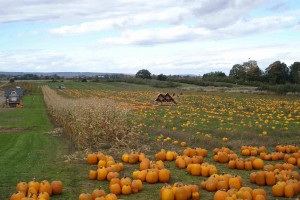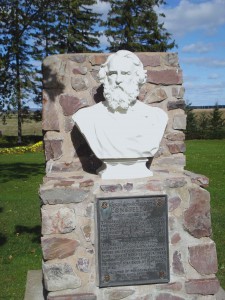 I love Nova Scotia’s Annapolis Valley in the autumn. The fall skies add a texture to the sunlight which paints the orange fields of pumpkins and the reds and yellows of the leaves in a surreal tone and clarity. The autumn air is as crisp as the Chardonnays and Rieslings for which the area is renowned.
I love Nova Scotia’s Annapolis Valley in the autumn. The fall skies add a texture to the sunlight which paints the orange fields of pumpkins and the reds and yellows of the leaves in a surreal tone and clarity. The autumn air is as crisp as the Chardonnays and Rieslings for which the area is renowned.
Quaint old homes, charming B&B’s and the bucolic character of the Grand Pre area belie the tragedy that occurred here almost 250 years ago.
The Acadian French, the original European settlers in Nova Scotia, had been ensconced here since the 1600’s. The vicissitudes of European wars, however, had placed them in British territory. Most of them were quite happy to continue tending to their farms and maintaining the dykes which kept the waters of the sea at bay from their fields. Few had any interest in involving themselves in conflicts brewed on the other side of the Atlantic Ocean.
The Acadians were content to live under British rule, but refused to take an oath of loyalty to the British Crown, fearing that they might be required to take arms against their own kinsmen. This was not acceptable to the British who perceived the Acadians as enemy aliens in their midst.
Hence in 1755 commenced the expulsion of thousands of Acadians from various parts of Nova Scotia. Locals say that the portion of this drama which unrolled in Grand Pre is so well known and so well documented thanks to a soldier, a poet and a jeweller and their respective efforts in the 18th, 19th and 20th centuries.
The soldier in question is one Lieutenant-Colonel John Winslow (1703-1774) of Massachusetts. In charge of the Deportation operations in this locale, he kept meticulous diaries of the events and logs of those rounded up for expulsion.
 Nearly one-hundred years later, in March, 1841, a poet by the name of Henry Wadsworth Longfellow (1807-1882) borrowed a book from the Harvard library entitled History of Nova Scotia by Thomas Chandler Haliburton. Mr. Haliburton had based most of his history of the Deportation on Winslow’s diaries. Inspired by this sad tale, Henry Wadsworth Longfellow penned the poem Evangeline, about a fictional Acadian heroine and her trials and tribulations before being united with her lover, Gabriel.
Nearly one-hundred years later, in March, 1841, a poet by the name of Henry Wadsworth Longfellow (1807-1882) borrowed a book from the Harvard library entitled History of Nova Scotia by Thomas Chandler Haliburton. Mr. Haliburton had based most of his history of the Deportation on Winslow’s diaries. Inspired by this sad tale, Henry Wadsworth Longfellow penned the poem Evangeline, about a fictional Acadian heroine and her trials and tribulations before being united with her lover, Gabriel.
Finally, a jeweller, John Frederic Herbin (1860-1923), an Acadia University graduate and one-time mayor of nearby Wolfville, decided to partially right the wrong his ancestors had suffered. In 1907 he purchased 14 acres of land on which an old Acadian church and cemetery once stood. This formed the nucleus of Grand-Pre National Historic Site which boasts serene, beautifully landscaped grounds and a lovely Acadian-style church fronted by a statue of Evangeline.
 Visitors can enjoy Grand Pre based in the nearby town of Wolfville. My wife and I chose the historic Blomidon Inn which provides fine dining and accommodations of Victorian grandeur.
Visitors can enjoy Grand Pre based in the nearby town of Wolfville. My wife and I chose the historic Blomidon Inn which provides fine dining and accommodations of Victorian grandeur.
There are a number of vineyards in close proximity including the first in the province, Grand Pre Winery located just up the road from the Historic Site. Stop by for tastings robust reds and complex whites, carry on to the park and if you happen to be here in mid-summer push on to Evangeline Beach where a substantial percentage of the world’s semi-palmated sandpipers stop to feed for a few weeks.
Wolfville’s Acadia University has cultural and sports events through the year. Its Saturday farmers’ market offers a unique mix of food and crafts with a polyglot ambiance due to the diverse nationalities attracted to the university. Antique hunters won’t be disappointed either nor will lovers of fine dining, culture vultures or those who seek a quality spa experience. Not bad for a small town in Nova Scotia!
Photo Credits
Photos © George Burden
“Non-consecrated Acadian style church at Grand-Pre National Historic Site: statue of Longfellow’s fictional Acadian heroine, Evangeline, in foreground”
“Bust of Longfellow at Grand-Pre National Historic Site”
“Field of pumpkins near Wolfville”


What is not touched upon here is WHERE the expelled Acadians went…they are the initial population of “Cajuns’ and the reason French is spoken in Louisiana… this part of the story is even more fascinating than the fictional Longfellow poem about Evangeline… this story needs a way more research..
Louisana isn’t the only region the Acadians settled in Ontario, Quebec, New Brunswick, Vertmont, etc …, but I do agree. It’ most fascinating.
Was on vacation in Nova Scotia about 15 years ago. Best vacation ever, as my fellow travelers took charge of the planning. Evangeline brought to life French family history. As I stepped in the church, a feeling of belonging / trouvaille came over me. I, without a doubt, experienced a deep connection with my ancestry I had so desired to acquaint myself with since my childhood.
My father who was also bi-langual inspired us watch a variety show called “Dan Masser” from Nova Scotia in the 60’s. I loved the songs, the dansing and the music. Even though it was in English, it didn’t matter to me.
One of my dreams was to one day go back to my roots. I was in my 40’s when that fantasy finally became reality for possibly the most ecstatic yet relaxing/fulfilling ten days of my life.
Alexander Graham Bell who travelled the world extensively settled in Nova Scotia after declaring it the most beautiful landscape he had ever seen.
I would love to go back in a heartbeat, but I know the experience couldn’t/wouldn’t be the same such as a first kiss. Perhaps my memories will carry me through.
A few years ago, I had the pleasure of seeing Natalie MacMaster perform at our local theater here in Burlington, Vermont. She’s one of Nova Scotia’s precious gems. I had, of course, purchased her albums when I was on vacation those years earlier. This, too, was another dream come through …